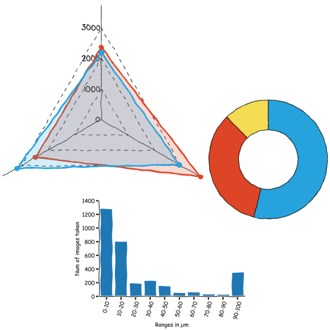Discover the capabilities of WaveMode AFM in characterizing bottlebrush polymers with unprecedented detail and speed, ...

The ultimate tool for nanoscale research from biological molecules to advanced new materials.
The versatile mid-range research AFM that grows with your demands in modes and accessories.
A compact affordable research AFM that is astoundingly easy to use, with more than 30 modes and options.
Fastest reliable sub-Angstrom surface roughness metrology.
Bringing the power of DriveAFM to a wafer metrology system purpose-built for the requirements of the semiconductor industry.
Measure roughness and other material properties of heavy and large samples up to 300 mm and 45 kg.
For unique requirements, we will design a bespoke AFM solution, leveraging our decades of engineering expertise.
Slide an AFM onto your upright optical microscope turret for a leap in resolution.
One of the smallest ever AFMs, created for integration into custom stages or existing setups.
A flexibly mountable research-grade scan head for integration into custom stages or existing set ups.
What is atomic force microscopy (AFM)? How does AFM work? What AFM modes do I really need? How do I get started with AFM?
Learn how AFM works with cantilever/tip assembly interacting with the sample. Explore CleanDrive technology, calibration methods, and feedback principles for precise nanoscale imaging.
An overview of common AFM modes. To learn about each mode in more detail and see application, view the full article.
We regularly publish detailed reviews providing practical guidance and theoretical background on various AFM applications.
Read detailed technical descriptions about selected AFM techniques and learn how to perform specific measurements on Nanosurf instruments.
A library of links to research papers in which Nanosurf instruments were used.
Learn AFM from our library of recorded webinars, covering different measurement techniques, modes, and areas of application.
Short video clips explaining how to perform different operations on Nanosurf instruments.
Watch a product demonstration to learn about the capabilities of our AFMs.
Short videos of our AFMs.
Browse news articles, press releases and a variety of other articles all around Nanosurf
Browse Héctor Corte-Léon's weekly experiments, for inspiration, entertainment, and to discover everyday applications of AFM.

Héctor here, your AFM expert at Nanosurf calling out for people to share their Friday afternoon experiments. Today, with some help from Denis Vasyukov and the SSRM module, I image the transistors on a mobile phone CPU.
Today's fridayAFM took one friday afternoon to do the AFM measurements, and several weeks of sample preparation (for which I have to thanks Denis Vasyukov who took care of doing all that preparation for me).
What we imaged? The finFET transistors on a mobile phone CPU (Samsung Samsung Exynos 8895 with 10 nm technology node).
Sample preparation required chip decapping with chemicals and cutting and polishing the cross section of the chip with focused ion beam (FIB).
AFM measurements where performed with the SSRM module to measure conductivity.
Here is the video summarizing it all:
Let's recap. We took the CPU from a phone and cut it in half using FIB to polish the exposed cross section. Then we measured conductivity using the SSRM module, which, with the help of some literature research, allowed us to identify the finFET structures.
I hope you find this useful, entertaining, and try it yourselves. Please let me know if you use some of this, and as usual, if you have suggestions or requests, don't hesitate to contact me.
Further reading:
New White Paper: Unveiling the Power of Electrical Modes
https://semiconductorian.wordpress.com/2021/08/06/giai-phau-bong-ban-dan-fet/
Extra:
For those with no time to go through the video.
We took a commercial smartphone and break it a part.

Then we extracted the CPU and removed the encapsulation using H2SO4.

Next, we used focused ion beam to cut the chip and have a polished cross-section.

Then using silver paste and a metal disc, the sample was mounted vertically to be able to image the edge.

The render of how we are going to image is something like this:

and the actual optical microscope view is this:

The different colors in the render indicate materials with different conductivity, and to measure conductivity we used scanning spreading resistance microscopy (SSRM), which is a type of conductive AFM that uses a logarithmic amplifier to measure conduction and be able to distinguish details between areas with high/low conductivity.

Next we capture the conductivity maps in Static mode with a DriveAFM.


The topography was hard to interpret

But the conductivity map was more straightforward. basically we were looking at some interconnections with high conductivity, some insulating parts, and the fine smaller details were likely transistors.

Doing some literature research online, it is very likely that the small features were FinFET transistors.

Probably two of them in the same orientation as they are represented in the Wiki article.
So, in summary. We demonstrate that measuring cross sections of integrated circuits is possible, and that SSRM has enough spatial and conductivity resolution to visualize FinFET devices.

28.10.2025
Discover the capabilities of WaveMode AFM in characterizing bottlebrush polymers with unprecedented detail and speed, ...

27.10.2025
Read this blog and discover advanced alloy engineering and cutting-edge AFM techniques for high-resolution, ...

14.10.2025
Discover how WaveMode technology resolves the tobacco mosaic virus structure under physiological conditions with ...

08.12.2024
Learn how to make a Python code to interface your AFM with a gamepad.

01.10.2024
FridayAFM: learn how the extreme sensitivity of AFM can reveal the glass ageing process.

11.07.2024
FridayAFM: learn how to perform datamining on large sets of AFM data.
Interested in learning more? If you have any questions, please reach out to us, and speak to an AFM expert.
